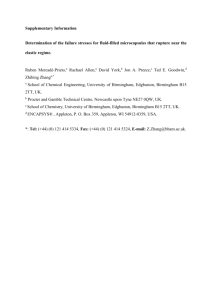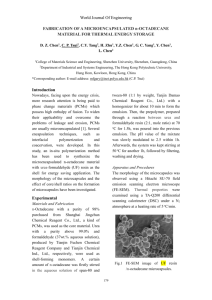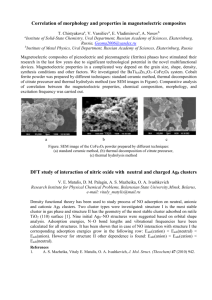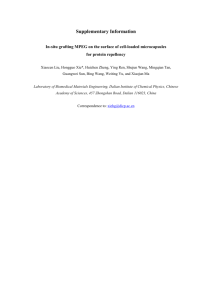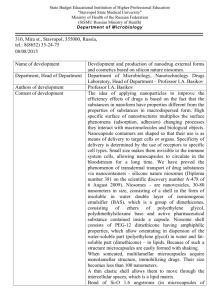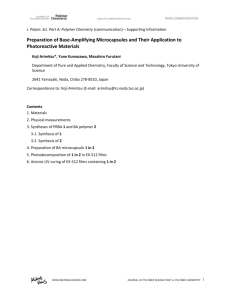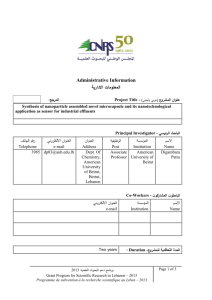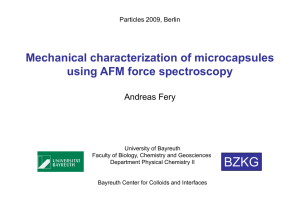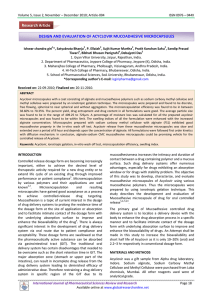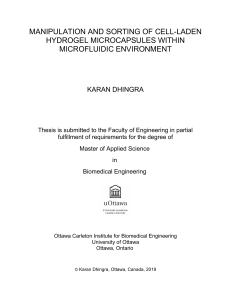Synthesis and Characterization of Biodegradable Polymer Microcapsules with Variable C/N/P Ratios
advertisement
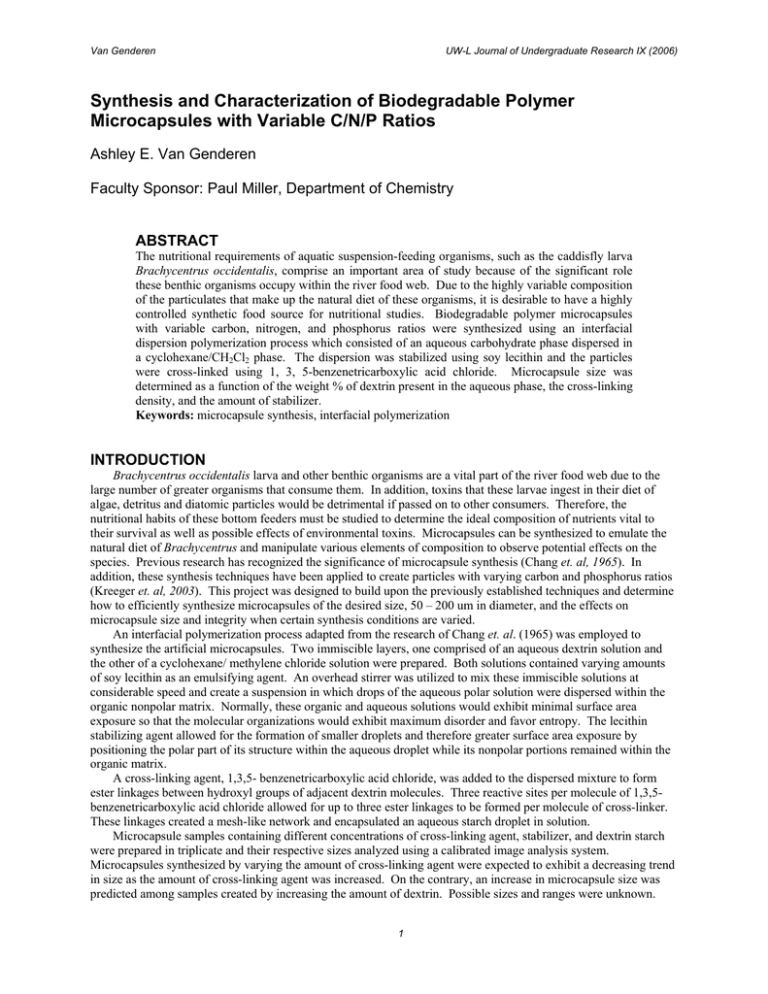
Van Genderen UW-L Journal of Undergraduate Research IX (2006) Synthesis and Characterization of Biodegradable Polymer Microcapsules with Variable C/N/P Ratios Ashley E. Van Genderen Faculty Sponsor: Paul Miller, Department of Chemistry ABSTRACT The nutritional requirements of aquatic suspension-feeding organisms, such as the caddisfly larva Brachycentrus occidentalis, comprise an important area of study because of the significant role these benthic organisms occupy within the river food web. Due to the highly variable composition of the particulates that make up the natural diet of these organisms, it is desirable to have a highly controlled synthetic food source for nutritional studies. Biodegradable polymer microcapsules with variable carbon, nitrogen, and phosphorus ratios were synthesized using an interfacial dispersion polymerization process which consisted of an aqueous carbohydrate phase dispersed in a cyclohexane/CH2Cl2 phase. The dispersion was stabilized using soy lecithin and the particles were cross-linked using 1, 3, 5-benzenetricarboxylic acid chloride. Microcapsule size was determined as a function of the weight % of dextrin present in the aqueous phase, the cross-linking density, and the amount of stabilizer. Keywords: microcapsule synthesis, interfacial polymerization INTRODUCTION Brachycentrus occidentalis larva and other benthic organisms are a vital part of the river food web due to the large number of greater organisms that consume them. In addition, toxins that these larvae ingest in their diet of algae, detritus and diatomic particles would be detrimental if passed on to other consumers. Therefore, the nutritional habits of these bottom feeders must be studied to determine the ideal composition of nutrients vital to their survival as well as possible effects of environmental toxins. Microcapsules can be synthesized to emulate the natural diet of Brachycentrus and manipulate various elements of composition to observe potential effects on the species. Previous research has recognized the significance of microcapsule synthesis (Chang et. al, 1965). In addition, these synthesis techniques have been applied to create particles with varying carbon and phosphorus ratios (Kreeger et. al, 2003). This project was designed to build upon the previously established techniques and determine how to efficiently synthesize microcapsules of the desired size, 50 – 200 um in diameter, and the effects on microcapsule size and integrity when certain synthesis conditions are varied. An interfacial polymerization process adapted from the research of Chang et. al. (1965) was employed to synthesize the artificial microcapsules. Two immiscible layers, one comprised of an aqueous dextrin solution and the other of a cyclohexane/ methylene chloride solution were prepared. Both solutions contained varying amounts of soy lecithin as an emulsifying agent. An overhead stirrer was utilized to mix these immiscible solutions at considerable speed and create a suspension in which drops of the aqueous polar solution were dispersed within the organic nonpolar matrix. Normally, these organic and aqueous solutions would exhibit minimal surface area exposure so that the molecular organizations would exhibit maximum disorder and favor entropy. The lecithin stabilizing agent allowed for the formation of smaller droplets and therefore greater surface area exposure by positioning the polar part of its structure within the aqueous droplet while its nonpolar portions remained within the organic matrix. A cross-linking agent, 1,3,5- benzenetricarboxylic acid chloride, was added to the dispersed mixture to form ester linkages between hydroxyl groups of adjacent dextrin molecules. Three reactive sites per molecule of 1,3,5benzenetricarboxylic acid chloride allowed for up to three ester linkages to be formed per molecule of cross-linker. These linkages created a mesh-like network and encapsulated an aqueous starch droplet in solution. Microcapsule samples containing different concentrations of cross-linking agent, stabilizer, and dextrin starch were prepared in triplicate and their respective sizes analyzed using a calibrated image analysis system. Microcapsules synthesized by varying the amount of cross-linking agent were expected to exhibit a decreasing trend in size as the amount of cross-linking agent was increased. On the contrary, an increase in microcapsule size was predicted among samples created by increasing the amount of dextrin. Possible sizes and ranges were unknown. 1 Van Genderen UW-L Journal of Undergraduate Research IX (2006) MATERIALS AND METHODS Extraction To prevent oil residues within the starch from contaminating microcapsule samples, an extraction apparatus was assembled. A portion of dextrin (Aldrich) starch was placed in a cardboard boot and extracted for a period of 12 to 24 hours using ethyl ether (Aldrich) as the solvent. After sufficient extraction time, the dextrin was removed, transferred to a beaker, and placed within a vacuum oven at negative 20-25 inches Hg relative to air pressure and 2540 oC. Thoroughly dried dextrin was stored and used for microcapsule synthesis. Aqueous and Organic Solutions A portion of dried dextrin was dissolved in 10 mL of 1M NaOH (Aldrich). Soy lecithin (Aldrich) was dissolved in both 100 mL of cyclohexane (Aldrich) and 50 mL of CH2Cl2 (Aldrich). Particle Synthesis An overhead stirring apparatus was assembled. A Sargent Cone Drive 50/60 cycle overhead stirrer was attached to a stir rod and plastic disc, which were supported and mounted by multiple clamps and rods. The disc was rested in the base of a three-necked 250 mL round-bottom flask, and spun to stir the contents of the flask. Initially, the cyclohexane/lecithin solution and aqueous dextrin in NaOH solution were mixed at constant speed for five minutes. The lecithin/CH2Cl2 solution was added after the five minute stirring period. Cross-linking agent dissolved in one mL of CH2Cl2 was immediately added to the mixture. Stirring was continued for an additional hour. Particle Washing Solution was transferred from the three-necked flask to a 250 mL Erlenmeyer flask. After microcapsules had clearly settled into a distinct layer at the bottom of the flask, the liquid layer was decanted. This layer of microparticles was rinsed with three separate 50 mL portions of cyclohexane, 95% Ethanol, and a 70:30 EtOH and H20 solution. Microcapsule samples were transferred to sealed glass bottles for storage in 50 mL of 70:30 EtOH and H20 solution. Slide Preparation Bottled samples were shaken to create uniform microcapsule dispersion. A portion of particles was extracted and pipetted into a small glass vial. To this sample was added approximately five mL of 95% EtOH. The microcapsules were manually re-suspended in solution and pipetted onto a glass slide for analysis. Image Analysis A digital camera attached to a Nikon Eclipse E400 microscope was used to capture 40x images of microcapsules from slide sections chosen at random. Images were sharpened and the contrast adjusted using the Nikon ACT-1 2.63 program. The Image-Pro Plus 5.1 computer program was employed to accurately determine microcapsule cross-sectional areas and diameters. Data Analysis A Microsoft Excel spreadsheet program was utilized to calculate the diameters of all microcapsules analyzed. Excel was also employed to average the diameters of the respective samples and create x-y plots of the results. RESULTS As the amount of cross-linking agent was increased and all other factors remained constant (amount of dextrin used was 2.00 grams and soy lecithin solutions were 5% w/v), a gradual decrease in microcapsule size was noted (Figure 1). Amount of 1,3,5- benzenetricarboxylic acid chloride varied from 0.500 grams to 1.50 grams per microcapsule sample. Corresponding microcapsule sizes ranged from 123.18 to 96.27 micrometers in diameter. 2 Van Genderen UW-L Journal of Undergraduate Research IX (2006) Diameter V. Amount Cross-linker 130 123.18 Diameter (u) 120 110.91 110 102.20 100 98.09 96.27 90 80 0.4 0.6 0.8 1 1.2 1.4 1.6 Amount X-linker (grams) Figure 1. The amount of cross-linking agent was varied. Experiments were performed in which the amount of dextrin was the only factor varied (cross-linking agent measured 1.00 grams and solutions were prepared using 8.33% w/v soy lecithin). The amount of dextrin used ranged from 8.33 to 50.0% w/v (Figure 2). As the quantity of dextrin increased, a relative increase in microcapsule size was noted, ranging from 83.77 to 190.45 microns in diameter. However, the microcapsules analyzed at 50 % w/v dextrin were slightly smaller in diameter than those synthesized using 40 % w/v dextrin starch. Diameter V. Percent Dextrin 200 190.45 Diameter (u) 180 185.56 160 147.60 140 120 113.64 100 83.77 80 60 5 15 25 35 45 55 Percent Dextrin (w/v) Figure 2. The percent dextrin w/v was varied. A series of microcapsules was created in which the percent lecithin was increased from 0.50 to 13.3 % w/v (Figure 3). For these experiments, the amount of dextrin was held constant at 2.00 grams and the cross-linking agent measured was consistently 0.75 grams. Partial trends were noted with this series. Microcapsule size increased up to a maximum of 113.11 microns in diameter, after which a decrease was observed. Diameter v. Percent Lecithin 120 113.11 Diameter (microns) 110 100.70 100 100.02 92.99 90 88.50 80 79.43 76.48 72.52 70 60 50 40 0 2 4 6 8 10 12 Percent Lecithin (w/v) Figure 3. The percent lecithin w/v was varied. 3 14 Van Genderen UW-L Journal of Undergraduate Research IX (2006) CONCLUSIONS The size trend exhibited by the microcapsules synthesized with increasing amounts of cross-linking agent was consistent with the hypothesis. As cross-linking density was increased, more ester linkages were formed among adjacent dextrin molecules. The increased linkages allowed for a tighter mesh network and smaller microcapsule formation. This “tighter” mesh network allowed for less particle expansion due to the osmotic pressure gradient from water wanting to enter the particles and dilute the concentrated carbohydrate solution inside the microcapsules. The data point corresponding to 1.50 grams of cross-linker was slightly greater than the point plotted for 1.25 grams. However, the difference in size was less than two micrometers. Further experimentation will be performed to determine if the minimum microcapsule size has been reached for the conditions. The increase in size observed with increasing dextrin concentration can also be explained by an osmotic pressure gradient. As the number of starch molecules per aqueous droplet increased, the desire of water to flow into microcapsules became greater, leading to an increase in size. This explanation is consistent with the results achieved. The final point of this data series fell lower than the previous point. The plotting of additional points will determine whether microcapsules reach a maximum at 40% dextrin w/v and what trend, if any, microcapsules exhibit after this point. The trend displayed by microcapsules synthesized under increasing concentrations of lecithin was twofold. An initial increase in size was observed, up to a maximum of 113.11 micrometers in diameter. After this point, a decrease in microcapsule size was noted with addition of stabilizing agent. Lecithin molecules possess both polar and nonpolar regions and allow for the stabilization of larger aqueous droplets within the organic matrix, up to a point. After this maximum, the shear mechanics of the system have been met and the formation of larger microcapsules is no longer possible. Additional lecithin stabilizes a greater number of microcapsules, although they are smaller in size. This project was successful in developing a highly efficient means to synthesize microcapsules using an interfacial polymerization process. The established trends can be used to create particles within the desired range for Brachycentrus dietary requirements both quickly and in large quantity. Future experimentation will examine the efficiency of these microcapsules to conserve their integrity over time. In addition, the ability to form microcapsules of varying compositions will be determined. ACKNOWLEDGEMENTS I would like to thank Dr. Paul Miller of the UW-L chemistry department for his continual support and encouragement. I would also like to thank Dr. Roger Haro of the UW-L biology department for his assistance with image analysis and the use of his laboratory equipment. Lastly, thanks to Dean Michael Nelson and the Dean’s Fellowship program for the financial support of this project. REFERENCES Chang T.M.S., MacIntosh F.C. & Mason S.G. (1996) Semipermeable aqueous microcapsules. I. Preparation and properties. Canadian Journal of Physiology and Pharmacology, 44, 115-128. Kreeger D.A., Hawkins A.J.S. & Bayne B.L. (1996) Use of dual-labeled microcapsules to discern the anabolic and catabolic fate of dietary protein in suspension-feeders. Limnology and Oceanography, 41, 208-215. Kreeger D.A., Kilham, S.S., Lanka, S. & A. Linder (2003) Preparation of phosphorus and carbohydrate microcapsules for manipulating dietary C: P ratio for aquatic suspension-feeders. Journal of Freshwater Biology, 48, 203-219. Langdon, C.J. (1989) Preparation and evaluation of protein microcapsules for a marine suspension-feeder, the Pacific oyster Crassostrea gigas. Journal of Marine Biology, 102, 217-224. 4
